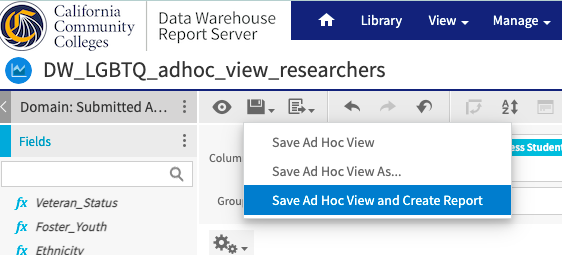| Info |
|---|
CCC Data Warehouse Report Server v7.8 Last Update: Feb 2022 |
...
Authenticator for Mac and Windows Chrome browsers is available free from the Chrome Web Store. This app installs very quickly to your desktop (recommended) as well as your phone, and includes a lot of great features that promote security and usability. NOTE: The entire download and install process takes less than one minute. You may need local IT authorization and assistance to install it if policy requires this.
To Install the Chrome Authenticator:
...
To run a report, click the name of a report in the repository. For example, click DW LGBTQ Report. The report appears in the Report Viewer.
...
On the Home page, click Create in the Reports block. The Create Report wizard opens.
Select the Ad Hoc view you want to use as the basis for your report.
Select a report template. To use a template other than the default, select Custom Report Template, click Browse and select the desired template. See Report Templates for more information.
Click OK. If asked, enter the input controls needed. See Using Input Controls.
You can now begin working with your report.
...
| Info |
|---|
Creating Filters with Relative DatesYou can filter information in your view based on a date range relative to the current system date. You can accomplish this using date-based filters, and entering a text expression describing the relative date or date span you want to display, using the format <Keyword>+/-<Number> where:
For example, if you want to see all of the CC Promise Grant Applications submitted during the prior week, your expression would be: WEEK-1. |
...
7. After running and/or exporting the LGBTQ report, click View → Repository to return to the repository to view the list of reports.
...
...
Customizing the LGBTQ Report Template
The process to create and save a custom version of the LGBTQ report template in the Repository, or any report template in the Data Warehouse Report Server, will depend on what you want changed and whether the change is temporary (one-off) or if you want to make long-term changes to the format, the data source, the data elements, and/or different or additional Input Controls (filters).
From the Repository:
Step 1: Copy the Report and the Ad Hoc View Public templates and paste the copies into your Organization folder(s).
Step 2: Find the copy of the Ad Hoc View and double-click to open it in the Ad Hoc Editor.
In the Ad Hoc Editor
Step 3: With your copy of the Ad Hoc View open in the Ad Hoc Editor, follow the steps provided in the XYZ section in the guide.
Option: To change the report format, do this
Option: To add or remove the data fields in the report, do this…
Option: To add or remove Input Controls in the report, do this…
Option: To add a Group to your table report, do this…
Step 4: Save your changes using the Save As > Save Ad Hoc View and Create Report function.
Step 1: Click the Save icon in the Ad Hoc Editor tool bar. | Step 2: In the dropdown menu, select Save Ad Hoc View and Create Report to open the Save As dialog menu. | Step 3: In the Save Ad Hoc View and Create Report dialog box, enter the names of your View and Report, and designate the folders where each will be saved. |
| Tip |
|---|
Helpful Tip: When saving the details of your custom Ad Hoc View and corresponding Report, keep the names and descriptions the same - or very similar - so you can identify the pair if you want to update your report in the future. Remember that every report is based on its original View, and if you want to change your report you need to make the changes in the corresponding View, and then save the changes as a new report. |
In the Save Ad Hoc View and Create Report dialog box, you will name and save both resources, ad hoc View in the Data View fields the new ad hoc View in the fields on the left side of the dialog box, then enter the name and select the folder for the corresponding Report in the right side dialog fields. The View provides the report type, format, data source and elements and filters (input controls) for the report you will run.


